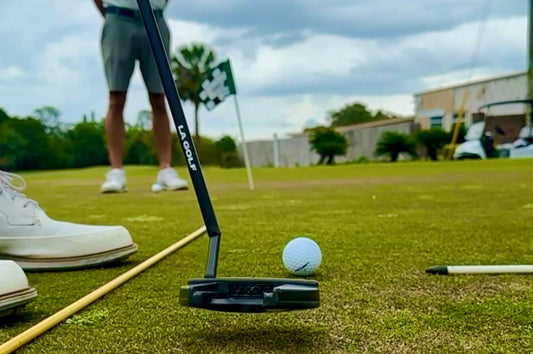Most golfers overthink putting, and the thoughts they obsess over are the wrong things to think about entirely. They buy expensive putters, stress over green reading, and practice stroke mechanics until their eyes bleed.
Here's what I've learned after 25 years of coaching players at every level: the magic happens before you even move the putter.
Your setup determines everything. Get it wrong, and no amount of practice will save you. Get it right, and suddenly those knee-knockers start dropping.
Why Your Grip Isn't Just About Holding the Club

The conventional wisdom says grip the putter lightly, around a 3 out of 10 pressure. That's not wrong, but it misses the bigger picture.
Watch Rory McIlroy or Scottie Scheffler address a putt. Their hands aren't just holding the putter — they're creating a unified system with their arms and shoulders. The reverse overlap grip, where your left index finger covers the fingers of your right hand, isn't some arbitrary tradition. It locks your hands together so they can't work independently and ruin your stroke.
You can absolutely use one of the various other styles of gripping the putter, but be fully aware that your goal is to have unified hands. Having competing hands throughout your stroke is a recipe for disaster.
Key Grip Do's:
-
Position the putter in your palms, not fingers
-
Use a reverse overlap grip or, if you use another style, understand that unity of your hands is critical
-
Maintain light but secure pressure (3/10)
-
Let your bigger muscles control the motion
I had a scratch golfer a few years back who was absolutely terrible on short putts. Good player otherwise, but man, he'd tense up over anything inside eight feet. Took me about ten minutes to figure out what was happening. He had a death grip on the putter, white knuckles and everything. As soon as I got him to loosen up and move that grip into his palms, those putts started going in. Amazing what happens when you stop fighting the club.
The Setup Secrets You Need to Know

Many golfers try to tell me that the way you set up to a putt is mainly a matter of personal preference. That's complete nonsense. Watch any tour pro putt — they're not doing whatever feels good, most are following principles that actually work.
Weekend golfers plant themselves like they're hitting a 300-yard drive — shoulder-width stance, locked and loaded for maximum power. Except putting isn't a power game. Hip-width apart lets you stay balanced while still allowing you to have that natural pendulum-like motion through the ball. Point your toes straight ahead, perpendicular to your target line — no fancy footwork needed.
Ball position trips up more players than anything else I see. They stick it way back in their stance, thinking they need to hit down on the ball like an iron shot. Wrong game entirely. Putting is about making clean contact at the bottom of your swing arc, when the putter face is perfectly square to the ground. Move that ball up — slightly forward of center in your stance, just off your lead armpit.
Perfect Putting Setup:
-
Feet hip-width apart, pointing straight ahead
-
Ball position slightly forward of center or just off your lead armpit
-
Weight distribution ever so slightly favoring the lead side
-
Slight forward lean from the hips until your eyes are just inside of being over the ball
Position the ball slightly forward of center, closer to your left foot if you're right-handed. This ensures clean contact and gets the ball rolling immediately instead of bouncing or skidding.
Weight distribution matters more than most realize. Your weight needs to be slightly favoring your lead side. This keeps you stable and helps promote an ever-so-slight downward approach into the ball with the putter head.
In terms of posture, lean slightly forward from your hips until your eyes are just inside the ball. This isn't just about seeing the line better—it positions your body so your arms can swing freely without interference.
Alignment: The Make-or-Break Fundamental

Perfect stroke mechanics mean nothing if you're aligned incorrectly. I've watched students miss three-footers because their alignment was off by two degrees.
Your body alignment should be parallel left of your target line (for righties), not aimed at the hole. Think railroad tracks: your body is on one track, the ball and target are on the other. Your feet, knees, hips, and shoulders all need to be parallel to that target line.
The putter face alignment is non-negotiable. It must be square to your target line at address. Even a degree or two off will send your putt wide on longer attempts. Use the alignment aids on your putter if it has them, or pick a spot on the ball to help you visualize square contact.
Alignment Checklist:
-
Body parallel to target line (not aimed at hole)
-
Putter face square to the target line
-
Match alignment to your green read, not the hole location
Green reading changes everything about alignment. A straight putt requires one setup, but a breaking putt requires you to align your body and putter face to match the ball's intended path, not the hole itself. This is where most weekend golfers lose strokes—they align to the hole instead of to their read.
The Setup Mistakes That Kill Confidence

Twenty-five years of coaching golfers at every level has shown me the same mistakes over and over. These aren't swing or stroke flaws — they're setup problems that create flaws.
Gripping too tightly is the most common error. Tension in your hands travels up your arms and into your shoulders, creating the jerky, inconsistent stroke that plagues high handicappers. Your grip should feel secure but not tight, like holding a small bird.
Poor posture ruins more putts than bad reads. Slouching or standing too upright changes your eye position and makes it impossible to see the line correctly. The slight forward lean from your hips isn't optional — it's the foundation of good putting posture.
Most Common Setup Mistakes:
-
Gripping too tightly (creates tension and inconsistency)
-
Poor posture (slouching or standing too upright)
-
Inconsistent ball position (changes angle of attack)
-
Overthinking once over the ball (creates doubt)
Ball position inconsistency might be the most damaging mistake of all. Moving the ball around in your stance changes your angle of attack and contact point. Find the position that works and stick with it for every putt.
The biggest mental mistake is overthinking once you're over the ball. Your setup routine should be automatic, leaving your mind free to focus on speed and line. Doubt creeps in when you start second-guessing your fundamentals.
Building Your Pre-Putt System

My best students don't just walk up and putt. They have systems that ensure a consistent setup every time. You need one too.
Start behind the ball to read the putt and pick your line. Walk to the ball and set your putter face square to that line first, then build your stance around it. This ensures your most crucial alignment — the putter face — is correct before anything else.
Pre-Putt System Steps:
-
Read putt from all angles, with behind the ball being last
-
Set the putter face square to the target line first
-
Build a stance around the putter face
-
Check grip pressure and hand position
-
Verify ball position and posture
-
Commit to your read and setup
Check your grip pressure and hand position. Make sure the putter sits in your palms and your hands are unified. Verify your ball position and posture. These checks should take seconds, not minutes.
The final step is committing to your read and setup. Once everything is in place, trust it. Doubt kills more putts than poor mechanics.
Why Practice Without Purpose Fails

Most golfers practice putting incorrectly. They hit ball after ball without focusing on setup fundamentals. This ingrains bad habits instead of building good ones.
Practice your setup away from the ball first. Use a mirror to check your posture and alignment. Work on your grip until it feels natural. Only then should you start hitting putts.
When you do practice with balls, focus on one fundamental at a time. Spend one session working only on grip, another on stance, another on alignment. This targeted approach builds muscle memory faster than trying to fix everything at once.
Effective Practice Strategy:
-
Practice setup fundamentals away from the ball first
-
Use mirrors and alignment aids for feedback
-
Focus on one fundamental per practice session
-
Master the basics at home before heading to the green
The best putting practice happens at home. Set up to a wall to check your posture, or use alignment sticks to verify your body position. These fundamentals don't require a green to master.
Your putting will improve dramatically once you understand that setup isn't just preparation — it's the foundation of every successful putt. Master these fundamentals, and you'll start making putts you never thought possible.





